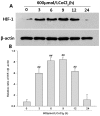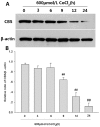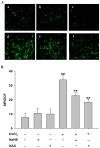Hydrogen sulfide protects against chemical hypoxia-induced injury by inhibiting ROS-activated ERK1/2 and p38MAPK signaling pathways in PC12 cells
- PMID: 21998720
- PMCID: PMC3187826
- DOI: 10.1371/journal.pone.0025921
Hydrogen sulfide protects against chemical hypoxia-induced injury by inhibiting ROS-activated ERK1/2 and p38MAPK signaling pathways in PC12 cells
Abstract
Hydrogen sulfide (H(2)S) has been proposed as a novel neuromodulator and neuroprotective agent. Cobalt chloride (CoCl(2)) is a well-known hypoxia mimetic agent. We have demonstrated that H(2)S protects against CoCl(2)-induced injuries in PC12 cells. However, whether the members of mitogen-activated protein kinases (MAPK), in particular, extracellular signal-regulated kinase1/2(ERK1/2) and p38MAPK are involved in the neuroprotection of H(2)S against chemical hypoxia-induced injuries of PC12 cells is not understood. We observed that CoCl(2) induced expression of transcriptional factor hypoxia-inducible factor-1 alpha (HIF-1α), decreased cystathionine-β synthase (CBS, a synthase of H(2)S) expression, and increased generation of reactive oxygen species (ROS), leading to injuries of the cells, evidenced by decrease in cell viability, dissipation of mitochondrial membrane potential (MMP) , caspase-3 activation and apoptosis, which were attenuated by pretreatment with NaHS (a donor of H(2)S) or N-acetyl-L cystein (NAC), a ROS scavenger. CoCl(2) rapidly activated ERK1/2, p38MAPK and C-Jun N-terminal kinase (JNK). Inhibition of ERK1/2 or p38MAPK or JNK with kinase inhibitors (U0126 or SB203580 or SP600125, respectively) or genetic silencing of ERK1/2 or p38MAPK by RNAi (Si-ERK1/2 or Si-p38MAPK) significantly prevented CoCl(2)-induced injuries. Pretreatment with NaHS or NAC inhibited not only CoCl(2)-induced ROS production, but also phosphorylation of ERK1/2 and p38MAPK. Thus, we demonstrated that a concurrent activation of ERK1/2, p38MAPK and JNK participates in CoCl(2)-induced injuries and that H(2)S protects PC12 cells against chemical hypoxia-induced injuries by inhibition of ROS-activated ERK1/2 and p38MAPK pathways. Our results suggest that inhibitors of ERK1/2, p38MAPK and JNK or antioxidants may be useful for preventing and treating hypoxia-induced neuronal injury.
Conflict of interest statement
Figures












Similar articles
-
Interaction between ROS and p38MAPK contributes to chemical hypoxia-induced injuries in PC12 cells.Mol Med Rep. 2012 Jan;5(1):250-5. doi: 10.3892/mmr.2011.623. Epub 2011 Oct 11. Mol Med Rep. 2012. PMID: 21993612
-
Heat shock protein 90 mediates cytoprotection by H₂S against chemical hypoxia-induced injury in PC12 cells.Clin Exp Pharmacol Physiol. 2011 Jan;38(1):42-9. doi: 10.1111/j.1440-1681.2010.05462.x. Clin Exp Pharmacol Physiol. 2011. PMID: 21083699
-
Inhibition of ROS-activated p38MAPK pathway is involved in the protective effect of H2S against chemical hypoxia-induced inflammation in PC12 cells.Neurochem Res. 2013 Jul;38(7):1454-66. doi: 10.1007/s11064-013-1044-x. Epub 2013 Apr 27. Neurochem Res. 2013. PMID: 23624824 Free PMC article.
-
ERK1/2 and p38α/β signaling in tumor cell quiescence: opportunities to control dormant residual disease.Clin Cancer Res. 2011 Sep 15;17(18):5850-7. doi: 10.1158/1078-0432.CCR-10-2574. Epub 2011 Jun 14. Clin Cancer Res. 2011. PMID: 21673068 Free PMC article. Review.
-
p38 MAP-kinases pathway regulation, function and role in human diseases.Biochim Biophys Acta. 2007 Aug;1773(8):1358-75. doi: 10.1016/j.bbamcr.2007.03.010. Epub 2007 Mar 24. Biochim Biophys Acta. 2007. PMID: 17481747 Review.
Cited by
-
Interaction between AhR and HIF-1 signaling pathways mediated by ARNT/HIF-1β.BMC Pharmacol Toxicol. 2022 Apr 26;23(1):26. doi: 10.1186/s40360-022-00564-8. BMC Pharmacol Toxicol. 2022. PMID: 35473600 Free PMC article.
-
Effect of Apremilast on LPS-induced immunomodulation and inflammation via activation of Nrf2/HO-1 pathways in rat lungs.Saudi Pharm J. 2023 Jul;31(7):1327-1338. doi: 10.1016/j.jsps.2023.05.022. Epub 2023 May 29. Saudi Pharm J. 2023. PMID: 37323920 Free PMC article.
-
Mefloquine exerts anticancer activity in prostate cancer cells via ROS-mediated modulation of Akt, ERK, JNK and AMPK signaling.Oncol Lett. 2013 May;5(5):1541-1545. doi: 10.3892/ol.2013.1211. Epub 2013 Feb 22. Oncol Lett. 2013. PMID: 23760395 Free PMC article.
-
Preferential activation of HIF-2α adaptive signalling in neuronal-like cells in response to acute hypoxia.PLoS One. 2017 Oct 2;12(10):e0185664. doi: 10.1371/journal.pone.0185664. eCollection 2017. PLoS One. 2017. PMID: 28968430 Free PMC article.
-
p38 mitogen-activated protein kinase gene silencing rescues rat hippocampal neurons from ketamine-induced apoptosis: An in vitro study.Int J Mol Med. 2018 Sep;42(3):1401-1410. doi: 10.3892/ijmm.2018.3750. Epub 2018 Jun 29. Int J Mol Med. 2018. PMID: 30035800 Free PMC article.
References
-
- Kimura H. Hydrogen sulfide as a neuromodulator. Mol Neurobiol. 2002;26:13–9. - PubMed
-
- Ishigami M, Hiraki K, Umemura K, Oqasawara Y, Ishii K, et al. A source of Hydrogen sulfide and a mechanism of its release in the brain. Antioxid Redox Signal. 2009;11:205–14. - PubMed
-
- Furne J, Saeed A, Levitt MD. Whole tissue hydrogen sulfide concentrations are orders of magnitude lower than presently accepted values. Am J Physiol Regul Integr Comp Physiol. 2008;295:R1479–85. - PubMed
-
- Kimura H. Hydrogen sulfide induces cyclic AMP and modulates the NMDA receptor. Biochem Biophys Res Commun. 2000;267:129–133. - PubMed
Publication types
MeSH terms
Substances
LinkOut - more resources
Full Text Sources
Research Materials
Miscellaneous

